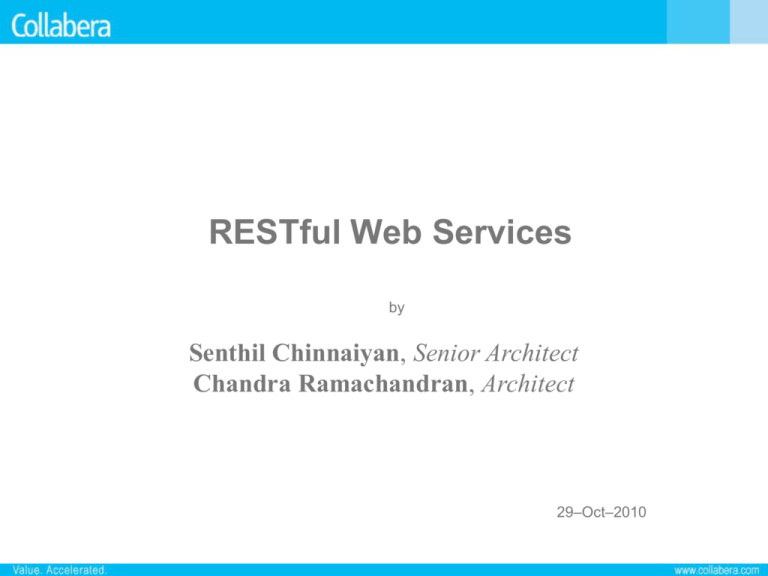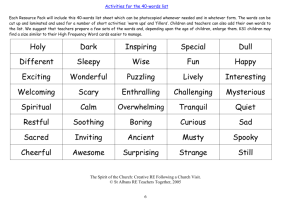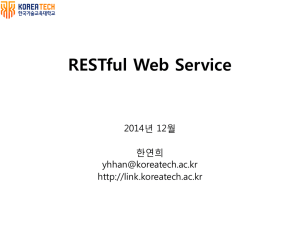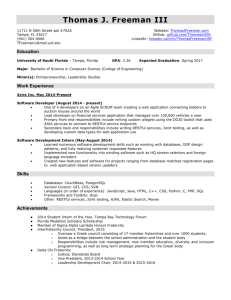RESTful Web Services
advertisement

RESTful Web Services by Senthil Chinnaiyan, Senior Architect Chandra Ramachandran, Architect 29–Oct–2010 Agenda • Part I Introduction What is REST? How does it work? RESTful Architecture REST vs SOAP REST – Why and When? • Part II JAX-RS Jersey RESTful Service – Deep dive Designing Service Implementing Service • Q&A 2 Part I REST Concepts 3 Introduction • In this modern world, enterprises are in the need of implementing Service Oriented Architecture (SOA) to achieve maximum business benefits • SOAP/WSDL/UDDI - SOA stack is the most common way and have failed to live up to their promise in some cases • Due to the complexity and high cost, enterprises are looking at alternatives to build their integration architecture in a simpler way. • In order to achieve low-cost, flexible integration, increased data security, and greater scalability, there is tremendous interest in REpresentational State Transfer (REST) architectural style 4 What is REST? • REST stands for “REpresentational State Transfer”, was introduced and defined in 2000 by the doctoral dissertation of Roy Fielding • REST is an architectural style which has set of constraints that can be applied on networking architecture to create RESTful architecture typically, on client server architecture. HTTP Request XML, JSON, HTML, TEXT etc HTTP Response Browser HTTP Request XML, JSON, HTML, TEXT etc HTTP Response Application Application 5 REST REST Server Server (Web (Web Services) Services) How does REST work? … • Resources can be anything, simple entity or entities • Hyperlink to a resource and the only way of exchange data between client and server • Actual data of the system and can be in any form • Each resource can be accessed by unique ID called URI • Example: Customer, Orders etc Resources • Representation is a temporal state of the actual data • Example: <domain>/depts/ <domain>/depts/finance <domain>/employees/senthil • Representation is sent back and forth between client and server • Example: XML, JSON, Text Text Representation URI … How does it work? REST in action • In REST URIs are used to connect clients and servers to exchange resources in the form of representations • In order to exchange data, REST relies on basic HTTP protocol methods: GET, POST, PUT and DELETE. 2 3 GET /emp/Senthil • 1 Accept header is used for representation RETRIEVE HTTP/1.1 Accept: text/xml 1 GET ... POST /emp/Senthil HTTP/1.1 Accept: text/xml Content-Type: text/xml <xml>… </xml> INSERT POST • 2 HTTP method is used for operation •3 URI is used to locate resources PUT /emp/Senthil UPDATE PUT HTTP/1.1 Accept: text/xml Content-Type: text/xml <xml>… </xml> 7 DELETE /emp/Senthil HTTP/1.1 Accept: text/xml Content-Type: text/xml <xml>… </xml> DELETE DELETE … How does it work? REST in detail (GET/RETRIEVE) • The method GET is used to RETRIEVE resources. • Client application makes a HTTP request with the method type GET and Senthil as the identifier GET /employees/Senthil HTTP/1.1 Host: localhost Date: Sat, 23 Oct 2010 Accept: text/xml • The representation type is set through the Accept request header Servlet Container ... Request • REST Framework invokes http://localhost:8080/restService/api/employees/senthil domain code to retrieve HTTP/1.1 200 OK Date: Sat, 23 Oct 2010 data and to generate Server: Apache/1.3.3.7 Client Application Content-Length: 438 Representation in XML Connection: close Content-Type: text/xml; charset=UTF-8 <xml> <emp> <fname>Senthil</fname> <lname>Chinnaiyan</lname> </emp> </xml> Response • Servlet container sends back the response as XML with 200 as the status code 8 REST Framework (REST Constraints) Domain Code (Business Logic) RESTful Service RESTful Architecture • A typical Java based RESTful architecture consists of 3 layers. • The Restful Service layer intercepts incoming http requests to identify the representation, resource and the operation • JAX-RS is the specification defined by Sun to create and use RESTful services in Java applications. http Client Application RESTful Service Layer (JAX-RS) Business Layer (Spring/Seam/EJB...) • The Business Layer uses appropriate framework to execute the business logic. • The Data Layer is responsible for data logic and takes care of O/R mapping. 9 Data Layer (Hibernate/iBatis/EJB...) jdbc RESTful Architecture Database REST vs SOAP? • Lightweight – easy to develop, no toolkits are required, works based on fundamental principles of HTTP and no contracts involved. • SOAP is complex, it requires greater implementation effort and understanding on the client side and server side. • The XML metadata information and SOAP headers associated with web services are considered to be an overhead than the HTTP headers. • HTTP itself is providing all facilities for an efficient, secured consumption of business logic and data, so SOAP and WS-* are considered overhead. • The stateless, highly scalable RESTful services are adopted in major key players such as Google, Amazon, Microsoft, Digg, Flickr and Twitter 10 Why and When? Consider REST: • REST may be considered if the service model is light, stateless, low cost, which requires improved data security and high scalability Consider SOAP: • REST does not enforce any service contract, if the service model requires stronger service contract between server and client, REST may not be an option. • Some of the SOAP capabilities such as transaction, policy are not standardized in REST • REST operates on stateless model, which may not be friendly for stateful service model 11 Part II REST Deep Dive 12 JAX-RS JAX-RS (Java API for RESTful Web Service) • JAX-RS provides support in creating Web Services according to the REST architectural style. • Simple, Annotation based, introduced in Java SE5 for the development and deployment of web services and clients. Annotations Description @Path Relative path for a resource class @GET, @PUT, @POST, @DELETE HTTP request type of a method @Produces Returned MIME media types @Consumes Acceptable request media types @Param** (Ex: @PathParam) Parameter values • Some of the Implementations of JAX-RS: • Apache CXF, Sun’s Jersey, Jboss’s RESTEasy, RESTlet, Apache Wink 13 Jersey • Jersey is a reference implementation of JAX-RS by Sun Microsystems. • Jersey implements all the REST constraints as defined by Roy. • Jersey implements support for the annotations defined in JSR-311, making it easy for developers to build RESTful web services with Java and the Java JVM. • Uses JAXB for XML to Objects Binding • Integrates well with Spring framework • Supports WADL (Web Application Description Language). WADL is the REST equivalent for WSDL 14 REST – How to? … RESTful web service life cycle can be summarized in the following six steps: 1. Requirements Gathering • Similar to traditional requirements gathering, need to identify what the RESTful services should do. 2. Resource Identification • Similar to OOAD, need to identify list of objects to be used in services. • These are typical model objects used within RESTful services. 3. Resource representation definition • It is the representation of resources that are exchanged between clients and servers, so we should define what kind of representation we need to use. • Typically, we use XML, but JSON has gained popularity for its simplicity. 4. URI Definition • Consists of URIs for clients and servers to exchange resources representations 15 … REST – How to? 5. Implementation • Environment Setup: Eclipse, Tomcat6, Jersey, Dynamic Web project • Controller: Receives and processes incoming Restful requests. Use JAX-RS Annotations for URL based method invocations • EmployeeManager: Provides CRUD on Employees • DepartmentManager: Provides CRUD on Departments • SearchManager: Provides Search feature on employees and departments • Model: Resources whose representations are exchanged between the client and the server • Employee, Department • Business/Data Logic: Perform operations on underlying data. • StorageService: All data operations are on done using static HashMaps for demo purposes 16 … REST – How to? 6. Testing Jersey Client API • Originally used for Jersey Unit testing, but applicable as a general RESTful client API • Provides a high level wrapper over low level CRUD operations on resources Java Http Client • Jakarta Commons HttpClient provides an efficient and easy-to-use tool kit for HTTP request/response operations Test Harness • Custom-built web application with a User interface to test RESTful Web services • Allows the user to select the “Accept” header, HTTP method, HTTP URL and the Request payload 17 Q&A Presentation and demo code can be downloaded from: www.collabera.com/SIJC.jsp Established in 1991, Collabera is a global, end-to-end information technology consulting and services company. With over 5000 professionals operating from 19 locations and 3 development centers worldwide, Collabera provides onsite, offsite and offshore services to global 2000 corporations. For more information about the company, visit www.collabera.com Thank You





![[#CARBON-13743] Key store password of catalina](http://s3.studylib.net/store/data/007841975_2-b5be293be17dfbfd4fa5374476b625ea-300x300.png)
